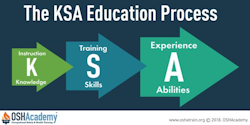Beyond OSHA Compliance
We want to make sure you firmly understand that, to be effective, your safety education program must include safety instruction, safety training, and safety experience.

Instruction, Training, and Experience
The learning process includes three basic components: safety instruction, hands-on training, and practical experience in the workplace.
Instruction and hands-on training are part of the learning process, followed by practical work experience on the job.
The KSA Education Process
So, what is the process we can use to educate employees to improve their safety performance? We call it the KSA Education Process.
It involves three basic strategies to educate employees to gain knowledge, increase their skills, and improve their abilities: instruction, training, and experience (ITE increases KSAs).
- Instruction transfers Knowledge. This is where the educational process begins. We must know something before we can do something.
- Training provides initial Skills with practice. Once we know something, we can focus on learning how to do something.
- Experience improves Abilities over time. Learners gain experience outside the classroom, where the "real education" occurs. Only with experience will we improve our overall performance.
We'll focus primarily on the first two components of the educational process in this module. But first, we'll look in the next section at the psychological process of being educated. Understanding the underlying psychology of being educated will help us understand that everything we experience, both internally and externally, educates us.
When employees know HOW to do safety and WHY it's important, they will more likely show personal safety leadership. For example, Gary, an OSHAcademy student wrote:
"I stress to my co-workers that a life jacket is mandatory on deck. We hired a young guy who was a swimmer in college. He felt his swimming skills were such that he did not need the jacket. We educated him on hypothermia and that he could not save himself if he fell over in 35-degree water. Once he understood the hazard, he wore the jacket at all times, because he wanted to, not because he had to."
Knowledge Check Choose the best answer for the question.
7-3. When will employees most likely demonstrate personal safety leadership when working alone?
You forgot to answer the question!

